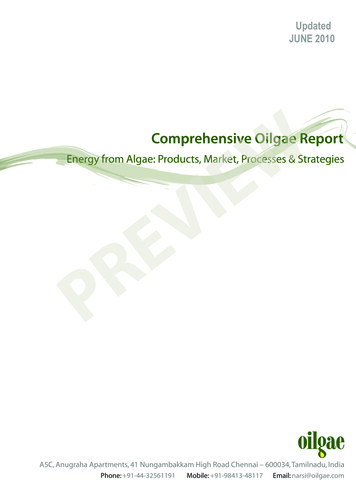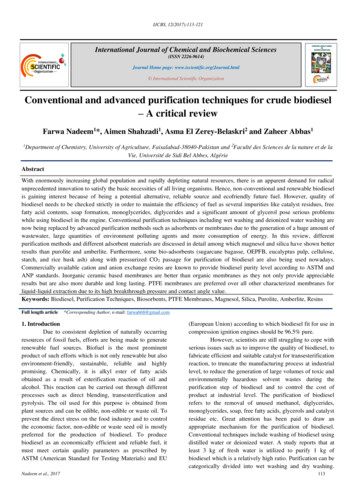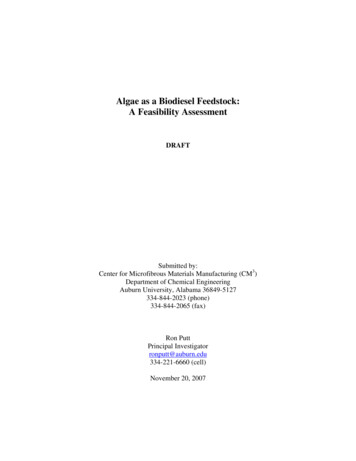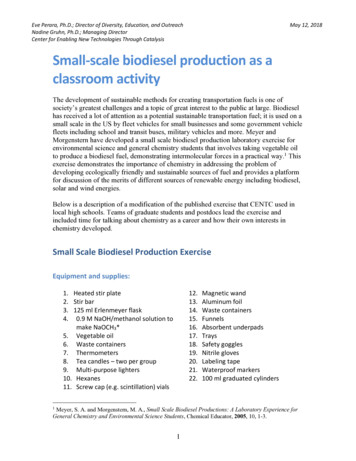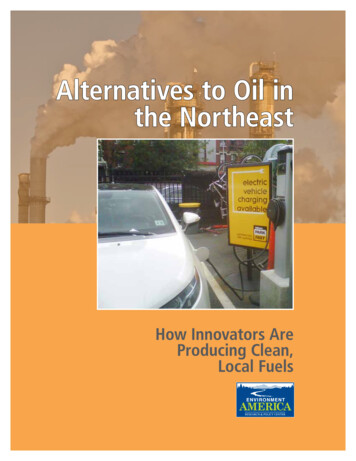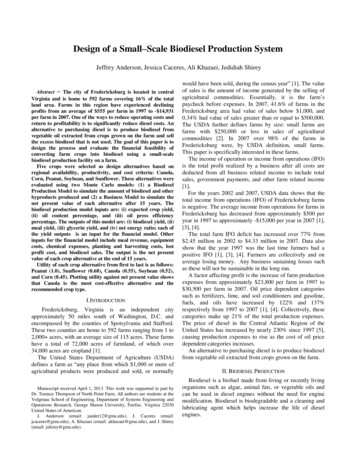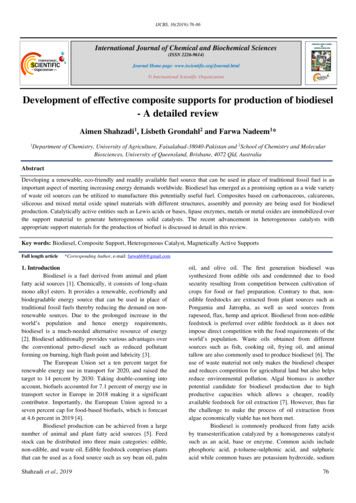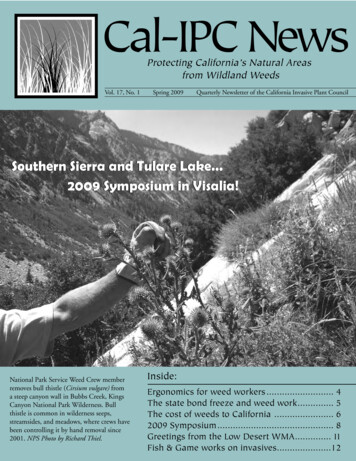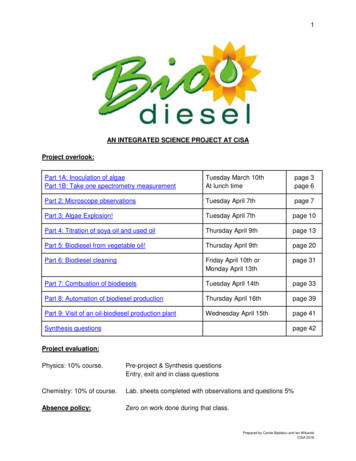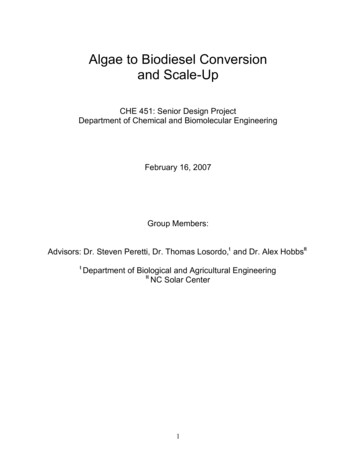
Transcription
Algae to Biodiesel Conversionand Scale-UpCHE 451: Senior Design ProjectDepartment of Chemical and Biomolecular EngineeringFebruary 16, 2007Group Members:Advisors: Dr. Steven Peretti, Dr. Thomas Losordo,ŧ and Dr. Alex HobbsŧŧŧDepartment of Biological and Agricultural EngineeringŧŧNC Solar Center1
TABLE OF CONTENTSSectionPageEXECUTIVE SUMMARY . 3INTRODUCTION . 5TECHNICAL BACKGROUND. 9PROJECT GOALS . 32PLAN OF ACTION. 34PROCESS DESCRIPTION . 38ENVIRONMENTAL CONSIDERATIONS . 47RELEVANT SAFETY CONCERNS AND DESIGN ISSUES . 49PROCESS FLOW DIAGRAM. 51BUDGET . 54REFERENCES . 562
EXECUTIVE SUMMARYIn recent years, global warming, world oil supply and demand, and energy security haveall played a part in the push for alternatives to petroleum-based fuels. Biodiesel is a viablealternative to the current use of petroleum-based fuels in the transportation sector because it is arenewable resource and can be used in traditional diesel engines with little or no modifications.Furthermore, it is environmentally friendly in that burning biodiesel does not result in a netcarbon dioxide increase. 1 Overall particulate emissions are also less for biodiesel compared toregular diesel. 2 The Algae Biodiesel Group has been investigating the potential for algal oil to beused as an alternative oil source for producing biodiesel. Algae are a promising feedstock forbiodiesel because it may have higher yields than oilseed crops currently used. 3The goal of this project is to successfully produce one liter of biodiesel fromScenedesmus algae, a strain of algae common to North Carolina. In order to accomplish this goal,the project was divided into four distinct steps: growth, harvesting, extraction, and conversion.Scenedesmus algae have been growing in the Undergraduate Teaching Laboratory sinceDecember 2006 in a photobioreactor (PBR). Algae are periodically separated from water byharvesting algae through dissolved air floatation. Oil will then be extracted from the algalbiomass using solvent extractions and an autoclave operated at elevated temperatures. This algaloil will then be converted into biodiesel using a transesterification process. During each step,scale-up possibilities will be studied for a pilot-plant design to determine the feasibility ofproducing algal biodiesel as a new alternative energy source for commercial sale.The algal species Scenedesmus was chosen for this study for several reasons. This strainis native to North Carolina and was found in high concentrations in ponds operated by the NCSUFish Barn. Scenedesmus also exhibits a high natural oil content ranging from 14 to 40% byweight. 4 Additionally, bristles are present on the corners of each cell to help space the algae formaximum nutrient and light absorption.A cell count calibration is being developed to determine the life-cycle stage of the algae.A UV-Visual Spectrophotometer and a hemocytometer are used to determine the concentrationof algal cells. On-going cell counts are used to create a cell count calibration. Should the amountof cells decrease, nutrients are added to the PBR. If cell counts continue to increase, noadditional nutrients are required; however, if cell counts stabilize after adding nutrients,harvesting is required.In order to separate algae from suspension a dissolved air floatation (DAF) procedurewas used. DAF is a separation technique that uses a pressure gradient to raise particle aggregatesto the top of a suspension. DAF requires a fraction of the input water to first be pretreated with aflocculant and then pressurized. The remainder of the liquid is in the depressurization column;1McCarl, et al. 2005Biodiesel Emissions3Sheehan, et al. 19984Microalgae23
this serves as the flocculation zone. DAF was chosen as a separation method because of the lowenergetic input and theoretical high yield; algal recoveries up to 98% have been obtained. 5Chitosan and alum were both tested as possible flocculants, with alum providing a betterseparation of algae from suspension. By using DAF, algae concentration increased from 6,800cells/mL to 314,000 cells/mL.Oil will be extracted from the concentrated algae obtained from the DAF technique usingthree methods: Bligh and Dyer solvent extraction, ethanol solvent extraction, and liquefaction.Ethanol solvent extraction involves combining dried algae mass with ethanol. Oil will separatefrom the algae cells and dissolve into the ethanol. The ethanol will then be evaporated, leavingoil behind. Bligh and Dyer solvent extraction involves combining wet algae and a chloroform,methanol, and water solution. The oil will separate from the algae cells into the chloroform phasecreating an immiscible layer, which can allow the algal oil to be decanted and collected.Liquefaction involves using an autoclave operating at 250 C and 3 MPa in the presence ofsodium carbonate as a catalyst. A combination of elevated temperature and pressure break downthe cell walls allowing for increased oil yields from the algal cells compared to solventextraction. All three of these methods will be studied to determine the maximum amount of oilthat can be extracted from the algal cells.Once algal oils have been obtained, conversion to biodiesel will be conducted using atransesterification reaction. Preliminary experiments for the transesterification of soybean oilinto biodiesel have been performed. By establishing a method for the conversion of soybean oil,the group will be prepared to repeat the procedure once algal oil is obtained. The acid value ofthe algal oil will be found through a titration with sodium hydroxide, which will determine theamount of basic catalyst to add. The algal oil will then be converted into biodiesel usingmethanol as a solvent over a sodium hydroxide catalyst. After the transesterification reaction,glycerin will be separated from biodiesel using a separatory funnel. The biodiesel will then bewashed with Magnesol using a Büchner funnel. In order to determine the physical properties ofthe produced biodiesel, future GC/MS tests will be performed.Scale-up feasibilities are being studied using SuperPro software. The overall process hasbeen designed to allow both 99% biodiesel and 99% glycerin products to be separated. A 1,000gallon biodiesel/week pilot plant will be designed and an economic feasibility analysis of boththe biodiesel and glycerin products will determine the plant’s profitability.The Algae Biodiesel group is currently on schedule to achieve the projects goals. In thecoming weeks, the group expects to extract oil from both the harvested algae and commerciallyavailable algae paste. Once algal oil has been obtained, a transesterification procedure will beconducted similar to the soybean oil procedure. In addition, an economic analysis of thesimulation process will be completed to help determine the feasibility of a large-scale algae-tobiodiesel production facility.5Sim, Goh, and Becker 19884
INTRODUCTIONMotivationsIn recent years, global warming, world oil supply and demand, and energy security haveall played a part in the push for alternatives to petroleum-based fuels. The IntergovernmentalPanel on Climate Change (IPCC) affirms that during the 20th century, the Earth’s averagetemperature increased by 0.6 C and will continue to increase anywhere from 1.5 C to 4.5 C bythe year 2100. 6 This increase in global temperature is enough to cause flooding in coastal regionsand make storms like Hurricane Katrina a more common occurrence. 7,8 The major force in risingglobal temperatures is anthropogenic carbon dioxide emissions, which accounts for 80% of allgreenhouse gases produced. 9Furthermore, the supply for petroleum-based fuels is declining. Currently, theOrganization of Petroleum Exporting Countries (OPEC) supplies 60% all the world’s oil needsand a quarter of US oil needs. These statistics are disturbing on two levels: (1) OPEC oilproduction is expected to plateau by 2010 and then decline by about 2030 and (2) the MiddleEast, where most participating nations in OPEC are located, is considered a region of politicalinstability. 10 Oil outside of OPEC is also expected to peak, with predictions for peak oilproduction ranging from 2018 to 2025. The US Energy Administration projects that in 20 years,US demand for oil will increase by 33%. In addition, the US is facing increased competition foroil from China. In 2002 China’s total energy consumption was less than that of many Europeannations, but by 2010, China is expected to be the second largest importer of oil. 11,12In 1980, the Carter Doctrine, stated in reference to oil that “an attempt by any outsideforce to gain control of the Persian Gulf region will be regarded as an assault on the vitalinterests of the United States of America, and such an assault will be repelled by any meansnecessary, including military force.” 13 This policy of resource hegemony has fueled oppositionin the form of asymmetric warfare against the US What the media now labels “terrorism” is aresponse to decades of resented US presence in the Middle East. Global security depends on theUS to shift its foreign policy away from resource dominance. 14 Furthermore, the Middle Eastitself is a region of political instability. If any disruption in oil supply were to occur there, aglobal oil crisis could result. 156McCarl, et al. 2005 300-301Weart 2003 68Sweet 2006 29McCarl, et al. 2005 30010Kerr 200511Salameh 200312Wright 200613Carter 198014Heinberg 2003 229-23015Salameh 200375
With such a large percentage of US oil coming from the Middle East and increasedcompetition and predictions of peak oil, it is vital that the US obtain a secure alternative energysource that reduces the nation’s dependence on foreign oil. The threat of global warming alsoputs pressure to find an energy source that is cleaner than the fossil fuels currently used.One option for an alternative energy that has received much attention in recent years ishydrogen. The use of hydrogen fuel cells is environmentally friendly for the consumer as theonly combustion product is water. However, the energy output of liquid fuels is much higherthan that of a fuel cell, even when the hydrogen is stored at 250 atmospheres. 16 Implementing asystem that would allow safely transporting the fuel cell creates an extremely difficultengineering scenario, one that cannot be bolted-on to current vehicles. Automobile producerswould have to invest in new materials and more costly manufacturing practices. Additionally, theimmediate technology still requires the use of fossil fuels as the source of hydrogen. 17In contrast to the hydrogen alternative, biodiesel is a more immediate option as arenewable fuel source. Biodiesel consists of alkyl esters of long chain fatty acids that are derivedfrom oils and fats produced by organisms. 18 Considering that 27% of US greenhouse emissionsare produced from the transportation sector and approximately two-thirds of the oil used in theUS is used for transportation, biodiesel is well-suited to replace petroleum fuel use inautomobiles. 19,20 In addition, biodiesel would require very little change to our existingtransportation infrastructure. Unlike many other alternative fuels, biodiesel can be used intraditional diesel engines with little or no modifications to the engine or fuel system.Furthermore, over forty federal and state fleets are already using biodiesel blends. 21Additionally, biodiesel has many environmental benefits. Sulfur emissions are virtuallyeliminated with biodiesel, since plants do not contain any sulfur. Sulfuric oxides are the chiefcomponents in the production of sulfuric acid, which produces acid rain. In addition, carbonmonoxide, various hydrocarbons, ozone, and particulate matter emissions are greatly reducedcompared to regular diesel. 22 Also, biodiesel produces no net increase in atmospheric carbondioxide concentrations. Plants and other photosynthetic organisms remove carbon dioxide fromthe atmosphere. When biodiesel derived from these photosynthetic organisms is burned, thecarbon dioxide is released into the atmosphere again, only to be recycled by other plants. Incontrast, burning fossil fuels releases 100% of the carbon stored without recycling it. 23 Biodieselis also energy efficient in that it can yield up to 320% more energy than is required in itsproduction. 2416http://www.unh.edu/Solomon, et al. 200418National Biodiesel Board 200619McCarl, et al. 200520Union of Concerned Scientists21Environmental Protection Agency 200222Biodiesel Emissions23McCarl, et al. 200524Sheehan,et al. 1998a176
Feasibility of Microalgal BiodieselRecently, an economic feasibility assessment was conducted on the production ofbiodiesel by Zhang et al. 25 They concluded that the break even price of biodiesel for the leastexpensive process studied would be 644 per ton, or 1.05 per gallon. This price does notinclude government subsidies, which would also reduce the price of biodiesel. In comparison,the average price per gallon of gasoline and diesel is, respectively, 2.292 and 2.567(November 27, 2006 average). 26 Additional reductions in the break-even price of biodiesel aredetermined by the sale price of glycerin. An increase in the price of glycerin would reduce theprice of biodiesel, however, glycerin prices are falling daily. Furthermore, they determined thecost of the feedstock oil plays a significant role in the feasibility of producing biodiesel. It isimportant to note that this price is the cost of manufacturing biodiesel -- not the market price forthe fuel. 27Around the world, many countries are embracing biodiesel as a new form of commercialenergy. The United Nations reports that biodiesel produced by developing countries can provideheat and energy while also helping to alleviate poverty by reducing petroleum costs. 28 Brazil hasbecome a world leader in biodiesel production, with over 500 million invested in two newbiodiesel production facilities. This increase in biodiesel production has allowed the Braziliangovernment to require a 2% addition of biodiesel to petroleum diesel by 2008. 29There are a number of animal fats and plants that can be used to produce biodiesel.Animal fats that are usually used include lard, yellow grease, and tallow. Plants that are typicallygrown for biodiesel include corn, cottonseed, peanut, rapeseed, and soybean. 30 Currently, thesupply of biodiesel from animal fats and plant oils is not enough to completely support theworld's energy needs. It is also not economically feasible to rely completely on plants and animalfats for biodiesel. Plants grown specifically for biodiesel compete for land with plants that aregrown specifically for agriculture. A large amount of land conversion from forestry and foodagriculture would be required; furthermore, not all land may be suitable for crops. 31 In addition,an increase in crops would be conducive to increased amounts of pesticide and fertilizer, whichwould damage the environment. 32Microalgae has been investigated as a potential source for biodiesel. The US Departmentof Energy reports that biodiesel produced from algae could see yields greater than oilseedcrops. 33 Microalgal biodiesel still has the environmental benefits of other biodiesel sources. It isestimated that if a 100 MW thermal plant using coal was replaced by algal biodiesel, carbondioxide could be mitigated by 1.5 105 tons/year using just 8.4 103 ha of cultivation area, a result25Zhang, et al. 2003Weekly Retail Gasoline and Diesel Prices27Zhang, et al. 200328United Nations29Dooley30Ma & Hanna 199931McCarl, et al. 200532Hill et al. 200633Seehan, et al. 1998267
that is very promising in light of global warming. 34 In contrast to agricultural sources forbiodiesel that require large tracts of land, algal biodiesel requires water and carbon dioxide.Algae, collected from sewage ponds, have created a potential for farmers to becomeenergetically self-sustaining. This can be made possible through an economically friendlymethod of producing biodiesel from sewage ponds. Pre-existing ponds can be used to grow algaerequiring only outside equipment to extract and convert the algae to biodiesel, reducing costs. Inaddition, algae ponds can be located next to coal-direct plants to capture generated CO2.Commercial production of biodiesel from algae has already been achieved recently by NewZealand based Aquaflow Bionomic Corp, however this technology is proprietary. 353435Sawayama, Minowa, Yokoyama 1999Kiong8
TECHNICAL BACKGROUNDAlgae convert inorganic material into organic material through photosynthesis.Photosynthesis provides the algae with the energy necessary for growth and reproduction.Carbon is fixed into organic compounds, and oxygen is released as a byproduct. Excess energy isstored within the algal cell in the form of lipids and fatty acids.Algae BiologyAlgae have evolved differently around the world, and it is estimated that there areanywhere from one to ten million different species of algae. 36 Aquatic algal organisms can bemicroscopic, as seen on the surface of a pond, or macroscopic, as seen in the kelp forests of theocean. These microalgae are made up of only one cell, while the macroalgae are comprised ofbranches of cells. Terrestrial algae also exist, and can survive in moist climates, or from asymbiotic relationship with lichens. 37 Algae exist as either prokaryotic or eukaryotic organisms.The only prokaryotic species of algae is cyanobacteria, which belongs to the phyla Cyanophyta.All species in the Cyanophyta phyla are microscopic. All other species of algae are eukaryoticand belong to the following phyla: Rodophyta, Chlorophyta, Ochrophyta, Haptophyta,Dinophyta, Cryptophyta, Euglenophyta, and Glaucophyta. 38 Macroscopic and microscopic algalspecies both exist within each phylum. The algae discussed in this paper are focused primarilyon microscopic algae rather than their macroscopic counterparts.It is often difficult to provide a well-defined set of characteristics for algae because thereis so much diversity even within the various phyla of algae. Cell wall, storage products, andphotosynthetic pigments vary in each phylum. Table 1 shows various distinguishing features ofthe major algae groups. All of the species in these phyla contain the photosynthetic pigment a.Chlorophyll pigment a absorbs light energy, which is ultimately converted to energy for the cellin the form of adenosine triphosphate (ATP). Accessory pigments, which vary according tophyla, help transfer light energy to pigment a. Excess energy from the photosynthesis process isstored in the form of polysaccharides. 39 As seen in Table 1, the storage products can also varyaccording to phylum. The form of storage depends upon how the glucose units link together. Alink between the α-1,4 linked glucans produces a starch storage product. A link between the β1,3-linked glucans produces a chrysolaminarin, laminarin, or a paramylon storage product. 4036Barsanti and Gualtieri 2006Graham and Wilcox 2000 638Sze 2006 1-339Sze 2006 240Sze 2006 7379
Algae ytaHaptophytaDinophytaTable 1: Characteristics of Algae Phylum. 41Photosynthetic PigmentsStorage Productschlorophyll a phycocyaninallphycocyanincyanophycin granules,phycoerythrincyanophytan ll -carotenexanthophyllschlorophyll a, bparamylonbetap-carotene, other carotenesand xanthophyllschlorophyll a, a, beta-carotenexanthophyllschlorophyll a, l a, cStarchbeta-carotenexanthophyllsCell CoveringPeptidoglycansome cellulosicproteinaceous pelliclebeneath plasmamembraneproteinaceous pelliclebeneath plasmamembraneCaCO3 scales commoncellulosic plates invesicles beneath plasmamembranesome naked; some withsilica/organic scales;cellulose, alginates insomeOchrophytachlorophyll a, odophytachlorophyll aphycocyaninphycoerythrinallophycocyaninalpha, beta-carotenexanthophyllsfloridean starchcellulose, sulfatedpolysaccharides; somecalcifiedChlorophytachlorophyll a, bbeta-carotene, other carotenesand xanthophyllsStarchwall of cellulose/otherpolymers; scales onsome; some naked; somecalcifiedLipids are hydrocarbons used for storage that are essentially insoluble in water. Algaecontain lipids as both membrane components and storage products. Lipids help control the flowof material into and out of the cell wall. They are responsible for the fluid nature of algal cells,which allow materials to be transferred through the cell. 42 The mechanism for lipid production inalgal cells is not fully understood. The lipid content of algae can vary with environmentalconditions. The Aquatic Species Program found that by decreasing various nutrients, such assulfur and nitrogen, algal oil production could be increased. The Aquatic Species Program also4142Barsanti and Gualtieri 2006Horton, et al. 2006 10-1110
studied the enzyme acetyl-CoA carboxylase or ACCase. This enzyme is believed to catalyze anearly reaction in lipid synthesis. 43 If this enzyme could somehow be cloned or magnified, thelipid content of an algal cell could be controlled. Table 2 below shows lipid contents for variousalgae species. The Aquatic Species Program determined that diatoms and green algae organismsshowed the most promise in extracting algal oil.Table 2: Lipid Contents of Various Algal Species. ophyta% Lipid9-1422-3014-206-811-2112 – 40211114-22Life Cycle of AlgaeThe life cycle of algae cultivated in limited volume such as in tanks and aquariums ischaracterized by five phases: the lag or induction phase, the exponential growth phase, decliningrelative growth phase, stationary cell numbers phase, and finally death.Induction PhaseDuring the induction phase the cells are preparing themselves for division by activatingenzymes and increasing their metabolism. They are not yet strong enough for cell division andcontinue to grow in size and strengthen while absorbing nutrients and light. Microalgae takenfrom a culture exhibiting exponential growth and placed in a new medium will still show a lagupon transfer. Using a re-enriched medium from a previous cultivation that exhibited fast growthwill cause a decrease in lag time in a new microalgae culture, as shown in Figure 2. 4543Sheehan, et al. 1998bMicroalgae45Fogg, G. E., 1965. 12.4411
Figure 1: Comparison of lag time and number of cells versustime. 46Exponential PhaseThe exponential phase of growth occurs afterthe microalgae have adapted to the medium and haveincreased their metabolism to the point that celldivision can occur. The growth of large populations ofnon-synchronously dividing cells is characterized bythe equation:ktW Wo e( ) (1)where k is the relative growth constant. The growthconstant is a function of temperature, light intensity,number of algae cells, the volume of algal material,concentrations of nutrients such as N2 in the cells, aswell as other environmental factors. The value of kincreases up to a maximum temperature of around35 C. 47 Above this temperature, the algae move into the declining relative growth phase andequation (1) is no longer valid.ReagentsNaNO3NaH2PO4 H2OMicroelement Stock SolutionVitamin SolutionMicroelement Stock SolutionFeCl3 6 H2ONa2 EDTAMnCl2 4 H2OCoCl2 6 H2OCuSO4 5 H2OZnSO4 H2ONa2MoO4 2 H2OVitamin SolutionBiotin (Vitamin H)Thiamine HCl (Vitamin B1)Cyanocobalamin (Vitamin B12)pH adjusted to 8.0 with 1 MNaOH or HClPer Liter0.075 g0.005 g1 mL1 mL3.150 g4.160 g0.180 g0.010 g0.010 g0.022 g0.006 g0.5 mg100 mg0.5 mgTable 3: Composition of the medium supplemented byf/2 formula. 48 f/2Exponential Phase: Growth ConditionsCertain growing conditions such astemperature, pH, lighting, and CO2 must becontrolled to grow any freshwater algae culturein limited volume. Although freshwater algaecan withstand temperatures from 10-35 C,optimal growth temperatures of the culturerange from 18-22 C. 49 Temperatures less than16 C and higher than 35 C will hinder celldivision; however, studies show that addinghigh levels of some nutrients, such as Bvitamins at 300 times the necessaryconcentration, allows microalgae to grow inextreme temperature conditions. 50 Optimallevels of nutrients to cultivate algae are shownin Figure 3. Transitions of temperatures shouldnot exceed 2 C in a short period of time toavoid shocking the algae. Microalgae can46Fogg 1965 14Fogg 1965 1748Gaultieri, et al. 2006 23149Gaultieri, et al. 2006 21350Fogg 1965 214712
withstand a pH range of 7-9; however, most algae grow optimally with a pH of 8.2-8.7. 51 Manyfactors affect the pH of the medium including temperature and CO2. Failure to maintain the pHcould result in a “complete cultural collapse” 52 as many cellular processes will fail. Lighting is amajor factor in the success of algae cultivation as it is a necessary element for photosynthesis.Microalgae react best to light in the blue spectrum, as this spectrum contains the most energy.Filters can be used to obtain the right intensity and wavelength of light. Many algae species growfaster initially in low light, but reach a population saturation point more quickly than algae thatgrow under intense light, as shown in Figure 4. This means that more light does not mean fastergrowth, but higher microalgae concentration. Most algae cultures do not grow well underconstant illumination. Lighting should be cycled throughout the day using a light/dark (LD) ratioof 14:10 or 12:12 hours. 53Figure 2: Relationship between chlorophyllproduction and light intensity . 54Concentrations of both O2 andCO2 should be maintained in limitedvolume cultivation. CO2 should makeup 1% of the aeration feed to themedium. An excessive amount of CO2will cause the pH to rise, potentiallycausing damage to the cultivation;however, some extra CO2 will act as abuffer to the CO2/HCO3- imbalance. 55Declining Relative Growth PhaseThe algae continues to grow exponentially until one or more of the following fiveconditions occur: the nutrients become exhausted, the supply of CO2 becomes exhausted, the pHof the medium is altered by metabolic activity of the culture, the intensity of light is reduced byself-shadowing, and/or autoinhibition. Onset of these conditions is characteristic of the transitioninto the declining relative growth phase. Exhaustion of nutrients and CO2 is caused byinadequate amounts of CO2 and nutrients, such as nitrogen and iron, being added to the system.This causes photosynthesis in the cell to slow, impeding the culture’s ability to strengthen fordivision; this in turn slows the overall growth rate. During photosynthesis, cultures releaseorganic acids as byproducts into solution. Over time, unless proper water changes are performed,increasing concentrations of these organic acids alter its pH causing the water to become moreacidic. 56 Freshwater algae thrive in a pH range of 8.2 to 8.7. 57 If pH changes are too drastic themetabolisms of the cells will slow, causing a declining rate of growth. Over time asconcentrations of algae in the medium increase, the amount of self-shading also increases,causing the overall light intensity received by the cells to decrease. The maximum algal layer51Gaultieri, et al. 2006 213Gaultieri, et al. 2006 21353Gaultieri, et al. 2006 21354Fogg 1965 2255Gaultieri, P., et. al. 2006. 214.56Fogg, G. E., 1965. 28.57Gaultieri, P., et. al. 2006. 213.5213
thickness before self-shading begins to take its toll on growth is 6mm. 58 Self-shading is anexponential function of density, as seen in Figure 5.Figure 3: Relationship between irradiance andalgae concentration. 59Autoinhibition is the last conditionthat can promote the declining relative growthphase. During metabolism, algae producesubstances that are toxic to them. Thesetoxins begin to accumulate in the mediumshortly after the exponential growth phasebegins. High concentrations of the substancebring algae growth to a standstill. 60Stationary Cell Numbers and Death PhaseShortly after one or more of thelimiting growth conditions takes effect, thefourth phase, characterized by a stationarynumber of cells, begins. During this phase,there is no accumulation of algae cells in themedia. Following this is the last phase, death.The stationary phase may last for weeksbefore the death phase begins, or transitionmay occur directly from the exponential growth phase to death. 61Algae Selection CriteriaThe microalgae selected for this study must meet several criteria. Most importantly, itmust be native to North Carolina. It should be a m
been designed to allow both 99% biodiesel and 99% glycerin products to be separated. A 1,000 gallon biodiesel/week pilot plant will be designed and an economic feasibility analysis of both the biodiesel and glycerin products will determine the plant's profitability. The Algae Biodiesel group is currently on schedule to achieve the projects goals.
